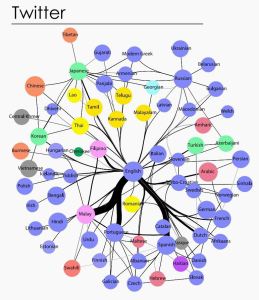
A new study mapping the flow of information online, and through book translations, found the languages that reach the most linguistically diverse readership tend to be the ones most connected by multilingual speakers.
“Links that speak: The global language network and its association with global fame” (Ronen et al) published in the latest issue of the Proceedings of the National Academy of the USA (12/30/14) uses the structure of the networks connecting multilingual speakers and translated texts, as expressed in book translations, multiple language editions of Wikipedia, and Twitter, to provide a concept of language importance that goes beyond simple economic or demographic measures. Researchers found that the structure of these three global language networks (GLNs) is centered on English as a global hub and around a handful of intermediate hub languages, which include Spanish, German, French, Russian, Portuguese, and Chinese. They validated the measure of a language’s centrality in the three GLNs by showing that it exhibits a strong correlation with two independent measures of the number of famous people born in the countries associated with that language. These results suggest that the position of a language in the GLN contributes to the visibility of its speakers and the global popularity of the cultural content they produce.
The researchers note that “Languages vary enormously in global importance because of historical, demographic, political, and technological forces. However, beyond simple measures of population and economic power, there has been no rigorous quantitative way to define the global influence of languages.”





